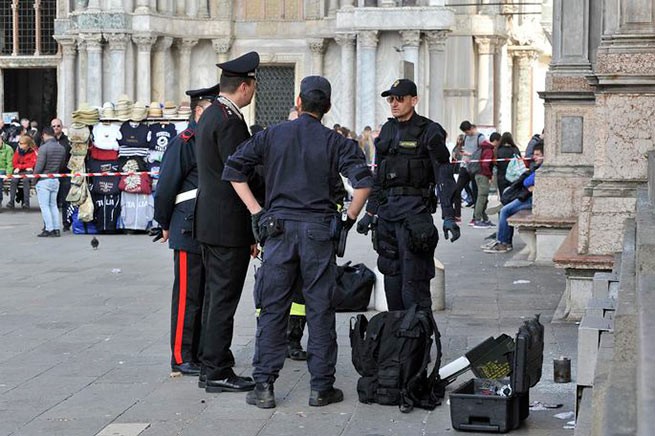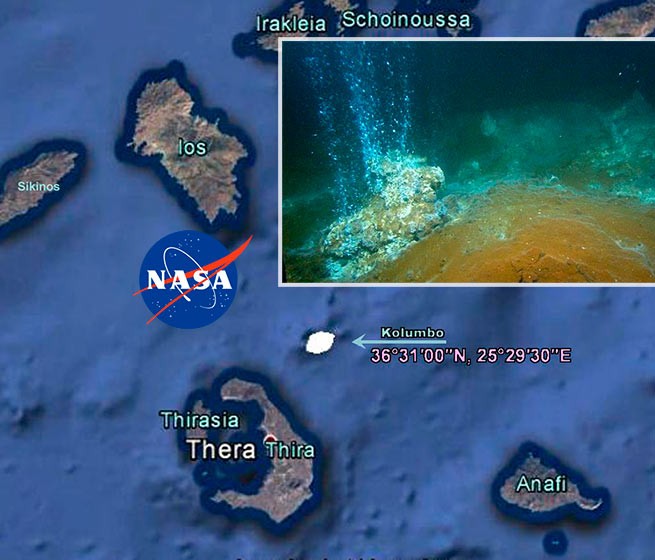Volcanologists are worried about the ever-increasing volume of magma that accumulates in a magma chamber located at a depth of about 3 km of the underwater volcano Columbo near Santorini.
An increase in the volume of magma dramatically increases the possibility of an eruption, which is why it is important that this volcano – the most active underwater volcano in the entire Mediterranean – be constantly monitored in real time. This is stated in a statement by the American Geophysical Union (AGU), based on a previous publication by foreign and Greek scientists in the journal Geochemistry, Geophysics, Geosystems.
Colombo, or Columbo, – an active underwater volcano, which is located 6.5 km northeast of the island of Santorini and belongs to the volcanic arc of the South Aegean Sea. This became known after a strong volcanic eruption on September 27, 1650. A small island was formed from the lava, which, however, quickly collapsed due to sea waves and turned into an underwater reef. The resulting tsunami caused damage at a distance of up to 150 km, killing more than 50 people.
Today, the Colombo Volcano is 280 meters high (compared to the surrounding seabed) and about 18 meters below sea level. Its crater has a diameter of about 3 kilometers and a depth of 512 meters. To a large extent, hydrothermal wells were discovered around the volcano, sources of hot water with temperatures up to 220oC, with dissolved metal elements that contain a rare ecosystem of filamentous bacteria.
Currently, in the area of Columbo Volcano, within the framework of the International Ocean Discovery Program (IODP), the international expedition No. 398 of the American research vessel JOIDES Resolution, in which Greek scientists from EKPA and ELKEΘE take part, is taking place. Researchers have just drilled northwest of Columbos to, among other things, find evidence of past eruptions in the area. However, it will be several months (starting in July) before the first results of the expedition are released, which will culminate in February with additional drilling in the Santorini caldera.
At the same time, Paraskevi Nomikou, Associate Professor of the Department of Geology and Geoecology of the University of Athens, who is on board the JOIDES Resolution, told APE-MPA that monitoring devices have already been placed in Columbo since early December with the help of the vessel of the Hellenic Research Institute of Geosciences and Natural Resources, in within the framework of the Greek research project SANTORY and with the financial support of the Municipality of Thera. She stressed that “monitoring of the volcano is carried out for the first time, in the coming months additional instruments will be installed, and the inhabitants of the island will be informed about the results of measurements by an international scientific group.”
Led by geophysicist Kajetan Khrapkiewicz and volcanologist Michele Paulatos of Imperial College London, and with input from Ms. Nomikos and Prof. Konstantinos Papazachos of the Aristotle University of Thessaloniki, the AGU study was based on an innovative analysis of seismic and other Columbos data obtained in during an earlier study by the Proteus expedition of another American research vessel in the area a few years ago. The results led the researchers to conclude: “The current state of the magma chamber indicates that an eruption with potentially significant consequences is possible in the future (although not imminent), so we recommend the deployment of a permanent observatory for continuous earthquake recording and seabed surveying. Our results show that that Columbus poses a serious threat and requires the establishment of a real-time monitoring center.” Something that has already begun to be implemented as part of the SANTORY project and the installation of scientific instruments on the Columbos seabed.
In 1650 AD, Columbo exploded, killing about 70 people on Santorini due to gas poisoning from the explosion. It was triggered by the accumulation of magma in a similar magma chamber, probably located at a corresponding depth of 3-4 km under the seabed. According to the researchers, the magma in the chamber tends to re-accumulate over time to a similar volume. They estimate that since the last volcanic eruption in 1650 AD, the magma chamber has grown at an average rate of about 4 million cubic meters per year. The total volume accumulated in the “reservoir” of magma (magma chamber) under Colombo is estimated at 1.4 cubic kilometers.
According to Khrapkiewicz, if the current rate of expansion of the magma chamber continues, then in the next 150 years, Columbo will reach the volume of magma of 2 cubic kilometers, which is estimated to have existed at the time of the 1650 AD eruption. But while the researchers say it is possible to estimate the future volume of magma, it is impossible to say with certainty when the volcano will erupt next.
The researchers say that while there does not seem to be an immediate danger, as Columbo is located at relatively shallow sea depths (about 500 meters), this would likely increase its explosiveness. When the eruption occurs, they predict it will send a tsunami and a column of ash tens of kilometers above sea level, which could have serious consequences for Santorini, which is only seven kilometers from Columbo.
The researchers hope that when combined, the new data from SANTORY and the ongoing IODP mission around Santorini will now provide a better idea of the area’s volcanic potential. As Professor Konstantinos Papazachos of the Aristotle University of Thessaloniki told APE-MPA, although Santorini has had a very good seismological and geodetic monitoring network for two decades, organized by the Institute for the Study and Monitoring of the Volcano of Santorini (IMPES), any additional data and information about Columbo is extremely useful. At the same time, he emphasized that these data will be used by an international research team under the coordination of the National Geological and Mineral Exploration Administration (EAGME) to assess the relative seismo-volcanic risk of Columbo in order to develop civil protection measures accordingly.
“We need more accurate data about what is actually hiding under these underwater volcanoes. Constant monitoring of them will allow us to better assess when an eruption may occur. With such systems, we will probably know about the eruption a few days before it starts so that people can evacuate the area and stay safe,” Khrapkevich said.







More Stories
D. Sariyannis: “We expect African dust in mid-May”
Dust from the Sahara: first results of analysis of chemical components
Lyrid meteor shower, make a wish on a shooting star